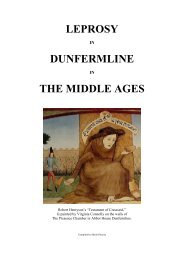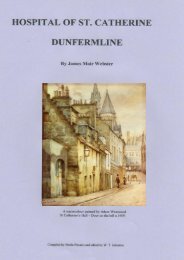PASSAGIUM REGINAE The - Royal Dunfermline
PASSAGIUM REGINAE The - Royal Dunfermline
PASSAGIUM REGINAE The - Royal Dunfermline
You also want an ePaper? Increase the reach of your titles
YUMPU automatically turns print PDFs into web optimized ePapers that Google loves.
<strong>The</strong>re is still much of the seventeenth and early eighteenth century masonry<br />
to be seen at Limekilns, and, as their foundations tell us, some of the „houses‟<br />
are built on the site of much older ones. But only „<strong>The</strong> King‟s Cellar,‟ as a<br />
habitable place, takes us back to a more remote period. Several doorways are<br />
out of place – they have belonged to older and more important buildings; but<br />
no doorway – excepting two in „<strong>The</strong> King‟s Cellar,‟ which are of much<br />
earlier date – belongs to a period earlier than the beginning of the seventeenth<br />
century, unless it be the one which is seen in Plate VIII. This doorway<br />
possesses an enormous lintel, made of two separate stones, the easternmost<br />
one of which extends so far east that it does duty for a quoin-stone as well.<br />
Having had no relieving-arch above it, it has given way on the west side.<br />
<strong>The</strong>re is a curious little „squinch‟ to the left of the doorway, which has beaten<br />
many heads to say why it is there.<br />
<strong>The</strong> best-known inscribed door-lintel in Limekilns to-day is one near the<br />
west end of the village in „Hackett‟s Ha‟‟ (or Hackett‟s Hall). Very simple,<br />
and but rudely incised, it recalls Joseph Wilson shipmaster, and his first wife,<br />
Margaret Finlayson, who were married in 1774. <strong>The</strong> house itself seems to be<br />
16




